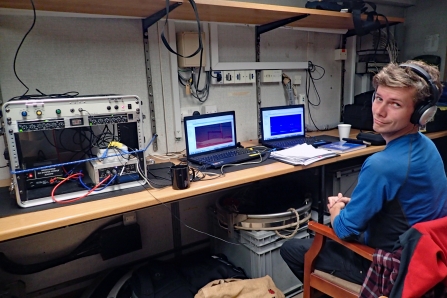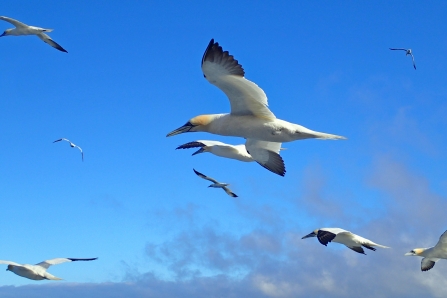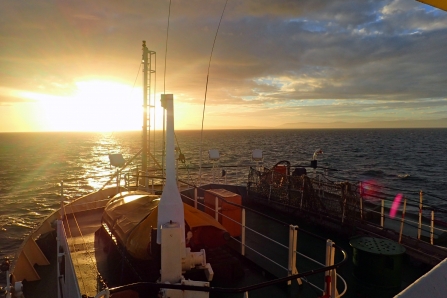The Scientist in Charge of the survey, Gavin McNeill, greeted me on board the ship and introduced the crew and scientific team who were off to make the most of their last hour on land for a few days. After being shown to my quarters where I met Tim, a researcher from Bangor University in north Wales, we were acquainted with the Corystes properly during our vessel induction with the First Officer. As the crew cast us off from Queen’s Quay I bid farewell to terra firma and dropped my things down to my room on the sub-deck. It was a comfortable set-up – with a single bed by the door, a sink and a writing desk beneath the single porthole.
Adam's Adventures on the AFBI Irish Sea Herring Acoustic Survey

Rejoining the team in the scientists lounge, Gavin briefed us on how the next few days should pan out. With the weather getting worse later in the week, he warned that tomorrow morning was possible our only shot at calibrating the sonar instruments that are essential for the whole of the survey. Before retiring for the night I stepped out on deck and watched the stars and Milky Way emerge in the sky as we made our way out of Belfast Lough.
I woke after a sound sleep at 6.45, took a pleasantly powerful, hot shower and took my seat for breakfast. My colleague James’ tales of the food on board were not exaggerated, I thought, as I tucked in to my first full fry of the voyage, lovingly prepared by the vessel’s Liverpudlian chef, Mike, and served by a gentleman called Harry. I later discovered that Harry was a former kick-boxer, so I made sure to clear my plate at every meal.
The morning and afternoon proceeded exactly to Gavin’s plan. With the weather holding well as we anchored in Luxey Bay off Isle of Man, and under the experience and skill of the scientists and technicians on board, the sonar instruments were calibrated on time. The calibration itself was a marvel to watch – a solid (and expensive) brass ball is manoeuvred under the vessel with the aid of some fishing line and three remotely controlled winches attached to the ships railing. The winches allow a scientist below deck to finely move the ball under the “view” of the sonar instruments and thereby calibrate the detectors.
The following morning I met Suzanne, AFBI’s leading cetacean scientist, who had boarded during the night and who I would be helping with the acoustic monitoring of porpoise and dolphins. Suzanne introduced me to Pam after lunch. Pam - or rather, the Passive Acoustic Monitoring device – is what enables cetacean scientists to listen for and even to “see” the underwater clicks and whistles of dolphins, whales and porpoises which are detected by a hydrophone towed behind the vessel and displayed on spectrograms in the monitoring station. This was all very new to me, and I can say that the novelty of listening to the ambient sounds of the sea lasted for at least 6 minutes before what felt like some of the longest hours of my life. It was oddly satisfying work though, I quite enjoyed the rhythm of the sea – punctuated by occasional porpoise clicks on screen, a handful of audible dolphin whistles and many cups of tea and ginger biscuits over the course of the survey. Unfortunately PAM could only be deployed when we weren’t likely to be sampling herring, so our time was quite limited. I was happy to split the time with Suzanne whenever I could and altogether I did about 10 hours of effort, that’s buttons compared to dedicated surveys!

Pam’s time was limited because the acoustic surveying was sort of piggy-backing on the main aim of the survey which was to inform the Irish Sea herring stock assessment, and assisting with this would be the bulk of my work on board. The Corystes follows a pre-determined transect across the whole Irish Sea, all the while pinging out sonar to detect shoals of fish below. When a shoal is detected, the skipper takes the ship back on itself and the crew cast out a small pelagic net to catch a sample for analysis (much to the amusement of the former fishermen among them). My first few tows came up with mixed shoals of herring and sprat, and the first job was to sort them by species. When tasked with sorting small, silver fish with blue-green backs from other small, silver fish with blue-green backs I was - no exaggeration - wholly convinced it was a wind-up. I watched incredulously and haplessly as more experienced eyes picked the herring from the sprat, but sure enough after a few of these kinds of catches I started to get my eye in.
These catches are not the most informative, however, and the real target were shoals of mature herring from which sub-samples could be weighed, sized, sexed and aged. Watching on the sonar monitor I could see that some of these shoals were hundreds of metres wide and at the very least as long. One of the crew told me that one year there had been a shoal around 4-500m wide and 4 miles long south of the Irish Channel. Historical records certainly attest to shoals of at least this size and much greater occurring regularly around these islands.


